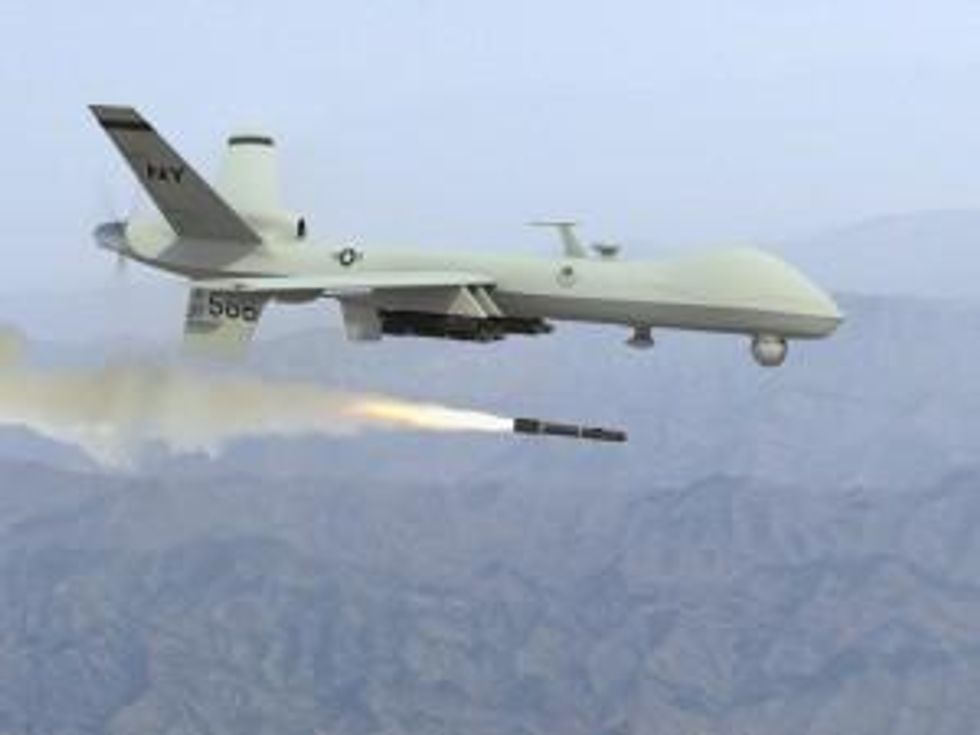Welcome Home From the Wars, Drones!
I mean, come on. You knew it had to happen, didn't you? In a 2010 Department of Homeland Security report, wrested from the bowels of the secrecy/surveillance state (thanks to a Freedom of Information Act request by the Electronic Frontier Foundation), the Customs and Border Protection agency suggests arming their small fleet of surveillance drones. The purpose: to "immobilize TOIs," or targets of interest, along the U.S.-Mexican border.
I mean, come on. You knew it had to happen, didn't you? In a 2010 Department of Homeland Security report, wrested from the bowels of the secrecy/surveillance state (thanks to a Freedom of Information Act request by the Electronic Frontier Foundation), the Customs and Border Protection agency suggests arming their small fleet of surveillance drones. The purpose: to "immobilize TOIs," or targets of interest, along the U.S.-Mexican border. Those arms would, of course, be "non-lethal" in nature. It's all so civilized. Kinda like the Star Trek folks putting their phasers on "stun," not kill. And count on it, sooner or later it will happen. And then, of course, the lethal weapons will follow. Otherwise, how in the world could we track and eliminate terrorists in "the homeland" efficiently?

All of this comes under the heading of self-fulfilling prophecy. You create and take to your battle zones a wonder weapon that, according to the promotional materials, will make the targeting of human beings so surgically precise it might even end the war on terror as we know it. (Forget the fact that, in the field, drones turn out, according to the latest military study of Afghanistan, to be far less precise than manned aircraft if you're measuring by how many civilians are knocked off, how much "collateral damage" is done.) Anyway, you use that weapon ever more profligately on distant battlefields in distant wars. You come to rely on it, even if it doesn't exactly work as advertised. And then, like the soldiers you sent into the same war zones (who didn't exactly work as advertised either), the weaponry begins to come home.
Drones? You can rant about them, write about them, organize against them, try to stop them from flying over your hometown. And still, like the implacable Terminators of film fame, they will arrive in "the homeland." Will? Have. As FBI Director Robert Mueller testified before the Senate Judiciary Committee recently, the Bureau is already using them. In a coda meant to relieve us all of drone anxiety, however, he pointed out that it's employing them "in a very, very minimal way and very seldom... we have very few." And, oh yes, the Drug Enforcement Agency and the Bureau of Alcohol, Tobacco, Firearms, and Explosives are testing drones for similar use. Also undoubtedly very minimally and very few, so don't fret (for now). As for police departments wielding armed drones, count on that, too, sooner or later.
In the meantime, those Border Patrol types, according to the New York Times, have been oh-so-happy to lend their military-grade Predator B drones to, among others, the North Dakota Army National Guard, the Texas Department of Public Safety, and the Forest Service. In 2012, they loaned their robotic planes out 250 times.
An Urgent Message From Our Co-Founder
Dear Common Dreams reader, The U.S. is on a fast track to authoritarianism like nothing I've ever seen. Meanwhile, corporate news outlets are utterly capitulating to Trump, twisting their coverage to avoid drawing his ire while lining up to stuff cash in his pockets. That's why I believe that Common Dreams is doing the best and most consequential reporting that we've ever done. Our small but mighty team is a progressive reporting powerhouse, covering the news every day that the corporate media never will. Our mission has always been simple: To inform. To inspire. And to ignite change for the common good. Now here's the key piece that I want all our readers to understand: None of this would be possible without your financial support. That's not just some fundraising cliche. It's the absolute and literal truth. We don't accept corporate advertising and never will. We don't have a paywall because we don't think people should be blocked from critical news based on their ability to pay. Everything we do is funded by the donations of readers like you. Will you donate now to help power the nonprofit, independent reporting of Common Dreams? Thank you for being a vital member of our community. Together, we can keep independent journalism alive when it’s needed most. - Craig Brown, Co-founder |
I mean, come on. You knew it had to happen, didn't you? In a 2010 Department of Homeland Security report, wrested from the bowels of the secrecy/surveillance state (thanks to a Freedom of Information Act request by the Electronic Frontier Foundation), the Customs and Border Protection agency suggests arming their small fleet of surveillance drones. The purpose: to "immobilize TOIs," or targets of interest, along the U.S.-Mexican border. Those arms would, of course, be "non-lethal" in nature. It's all so civilized. Kinda like the Star Trek folks putting their phasers on "stun," not kill. And count on it, sooner or later it will happen. And then, of course, the lethal weapons will follow. Otherwise, how in the world could we track and eliminate terrorists in "the homeland" efficiently?

All of this comes under the heading of self-fulfilling prophecy. You create and take to your battle zones a wonder weapon that, according to the promotional materials, will make the targeting of human beings so surgically precise it might even end the war on terror as we know it. (Forget the fact that, in the field, drones turn out, according to the latest military study of Afghanistan, to be far less precise than manned aircraft if you're measuring by how many civilians are knocked off, how much "collateral damage" is done.) Anyway, you use that weapon ever more profligately on distant battlefields in distant wars. You come to rely on it, even if it doesn't exactly work as advertised. And then, like the soldiers you sent into the same war zones (who didn't exactly work as advertised either), the weaponry begins to come home.
Drones? You can rant about them, write about them, organize against them, try to stop them from flying over your hometown. And still, like the implacable Terminators of film fame, they will arrive in "the homeland." Will? Have. As FBI Director Robert Mueller testified before the Senate Judiciary Committee recently, the Bureau is already using them. In a coda meant to relieve us all of drone anxiety, however, he pointed out that it's employing them "in a very, very minimal way and very seldom... we have very few." And, oh yes, the Drug Enforcement Agency and the Bureau of Alcohol, Tobacco, Firearms, and Explosives are testing drones for similar use. Also undoubtedly very minimally and very few, so don't fret (for now). As for police departments wielding armed drones, count on that, too, sooner or later.
In the meantime, those Border Patrol types, according to the New York Times, have been oh-so-happy to lend their military-grade Predator B drones to, among others, the North Dakota Army National Guard, the Texas Department of Public Safety, and the Forest Service. In 2012, they loaned their robotic planes out 250 times.
I mean, come on. You knew it had to happen, didn't you? In a 2010 Department of Homeland Security report, wrested from the bowels of the secrecy/surveillance state (thanks to a Freedom of Information Act request by the Electronic Frontier Foundation), the Customs and Border Protection agency suggests arming their small fleet of surveillance drones. The purpose: to "immobilize TOIs," or targets of interest, along the U.S.-Mexican border. Those arms would, of course, be "non-lethal" in nature. It's all so civilized. Kinda like the Star Trek folks putting their phasers on "stun," not kill. And count on it, sooner or later it will happen. And then, of course, the lethal weapons will follow. Otherwise, how in the world could we track and eliminate terrorists in "the homeland" efficiently?

All of this comes under the heading of self-fulfilling prophecy. You create and take to your battle zones a wonder weapon that, according to the promotional materials, will make the targeting of human beings so surgically precise it might even end the war on terror as we know it. (Forget the fact that, in the field, drones turn out, according to the latest military study of Afghanistan, to be far less precise than manned aircraft if you're measuring by how many civilians are knocked off, how much "collateral damage" is done.) Anyway, you use that weapon ever more profligately on distant battlefields in distant wars. You come to rely on it, even if it doesn't exactly work as advertised. And then, like the soldiers you sent into the same war zones (who didn't exactly work as advertised either), the weaponry begins to come home.
Drones? You can rant about them, write about them, organize against them, try to stop them from flying over your hometown. And still, like the implacable Terminators of film fame, they will arrive in "the homeland." Will? Have. As FBI Director Robert Mueller testified before the Senate Judiciary Committee recently, the Bureau is already using them. In a coda meant to relieve us all of drone anxiety, however, he pointed out that it's employing them "in a very, very minimal way and very seldom... we have very few." And, oh yes, the Drug Enforcement Agency and the Bureau of Alcohol, Tobacco, Firearms, and Explosives are testing drones for similar use. Also undoubtedly very minimally and very few, so don't fret (for now). As for police departments wielding armed drones, count on that, too, sooner or later.
In the meantime, those Border Patrol types, according to the New York Times, have been oh-so-happy to lend their military-grade Predator B drones to, among others, the North Dakota Army National Guard, the Texas Department of Public Safety, and the Forest Service. In 2012, they loaned their robotic planes out 250 times.

